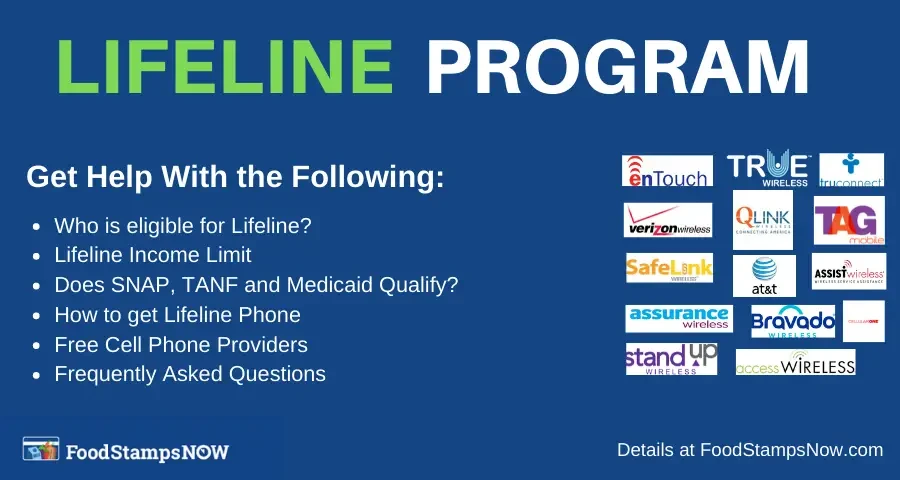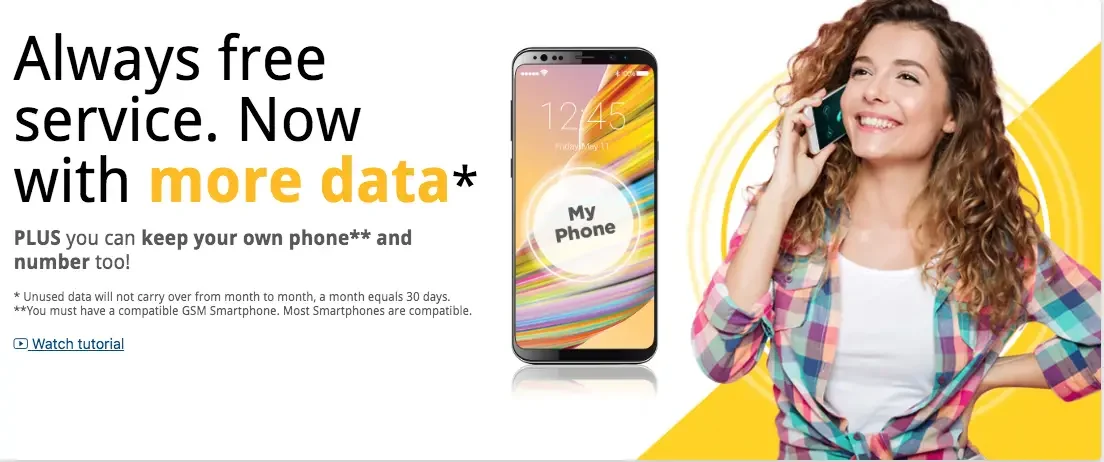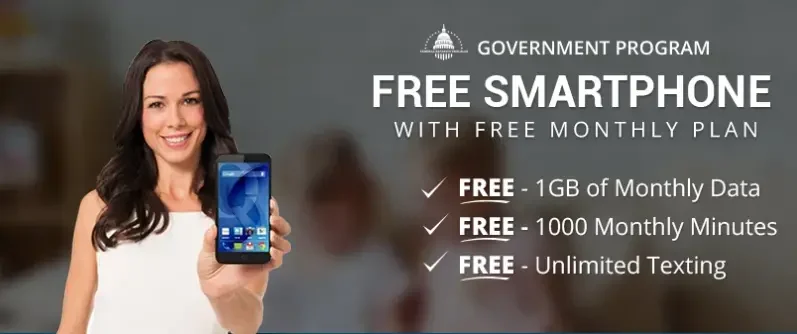The Lifeline phone program is a federal program that offers discounted phone or internet service for qualified low-income customers.
Eligible customers will get at least a $7.25 discount on their phone bill or a discount of $9.25 on their Internet bill.
You can get one Lifeline discount (phone or Internet, but not both) per household.
In this post, we will review in detail what the Lifeline phone program is about, the eligibility criteria, income limit, how to apply, and what you need to submit a successful application and get approved.
Most Lifeline phone service providers offer free monthly programs that include free phones, text, data and calling plans.
We will also review examples of the FREE lifeline program by select providers and how you can sign up.
This post on the lifeline phone program will cover:
- How to Get Lifeline Phone
- Lifeline Program Questions and Answers
- List of Free Lifeline Cell Phone Programs

How to Get Lifeline Phone
There are three steps to getting a Lifeline phone
Step 1: Qualify for Lifeline Program
There are two ways to qualify for the Lifeline phone program:
Lifeline Program Income Limit
The first option to qualify for the Lifeline phone program is to meet the income limit.
To meet the income limit, your income must be at or below 135% of the Federal Poverty Guidelines.
Below is the Lifeline Phone Program income limit:
135% of the Federal Poverty Guidelines
| Household Size | 48 Contiguous States, D.C., and Territories | Alaska | Hawaii |
| 1 | $16,862 | $21,060 | $19,413 |
| 2 | $22,829 | $28,526 | $26,271 |
| 3 | $28,796 | $35,991 | $33,129 |
| 4 | $34,763 | $43,457 | $39,987 |
| 5 | $40,730 | $50,922 | $46,845 |
| 6 | $46,697 | $58,388 | $53,703 |
| 7 | $52,664 | $65,853 | $60,561 |
| 8 | $58,631 | $73,319 | $67,419 |
| For each additional person, add | $5,967 | $7,466 | $6,858 |
Option 2 – Participation in Certain federal assistance programs
If you participate in one of the following federal assistance programs, you may be eligible for the Lifeline phone program.
Participation by you or someone else in your household in one of the following federal assistance programs meets the eligibility requirements:
- Medicaid (Medicare is not acceptable)
- Supplemental Nutrition Assistance Program (SNAP), also called Food Stamps
- Supplemental Security Income (SSI)
- Veterans and Survivors Pension Benefit Program
- Federal Public Housing Assistance (Section 8)
If you live in Michigan you may qualify based on the following additional programs:
- Michigan: Temporary Assistance for Needy Families (TANF), Low-Income Energy Assistance Program (LIHEAP), The National School Lunch Program’s Free Lunch Program.
If you live on Tribal Lands in California, Florida, Kansas, Massachusetts, Nevada or Wisconsin, additional qualifying programs include:
- Tribal Temporary Aid for Needy Families (Tribal TANF)
- Bureau of Indian Affairs General Assistance
- Food Distribution Program on Indian Reservations
- Head Start (Tribal Only)
Step 2: Choose a Lifeline Provider
You have to apply for Lifeline through a Lifeline phone or internet provider in your state. See the list of Lifeline providers by state.
Step 3: Apply for the Lifeline Program
Ask your Lifeline provider for a Lifeline application. You will need the following information to apply:
What documentation do you need?
Here’s what you need to apply:
- Government Issued Photo ID or Driver’s License.
- One (1) Eligibility Document (like your program award letter)
PROGRAM ELIGIBILITY DOCUMENTS
- Program award letter (i.e. SNAP or Medicaid) clearly showing your full name and program name
- Document with your program ID, name and benefit name
- Letter from State Agency stating you receive the benefit
INCOME ELIGIBILITY DOCUMENTS
- Last year’s income tax return
- Social Security statement of benefits
- Divorce decree
- Child support award
- Retirement/Pension statement of benefits
- Veterans Administration statement of benefits
- Unemployment/Worker’s Compensation statement of benefits
- Federal or Tribal notice letter of participation in General Assistance
- Other official document showing income information
Note: Effective 12/1/19, the federal government is reducing the Lifeline discount on stand-alone voice service from $9.25 to $7.25 per month.
Lifeline Phone Program Questions and Answers
Here are the most frequently asked questions we get about the Lifeline Phone Program:
What is the Lifeline Assistance Program?
Lifeline is a government assistance program that can provide a discount on your monthly phone or internet service bill if you qualify.
What are the requirements to be eligible for the Lifeline program?
There are two ways to qualify for the Lifeline phone program.
You can qualify through income if your income is at or below 135% of the Federal Poverty Guidelines. See the table above under income limits for details.
The other option to qualify is if you participate in one of the following government benefits programs:
- Supplemental Nutrition Assistance Program (SNAP), also known as Food Stamps
- Medicaid
- Supplemental Security Income (SSI)
- Federal Public Housing Assistance (FPHA)
- Veterans Pension and Survivors Benefit
- Tribal Programs (and live on federally-recognized Tribal lands)
How do I Sign up for the Lifeline Program?
You can apply for Lifeline through a Lifeline Program provider in your state (scroll below to see a provider in your state).
How much does lifeline cost per month?
The Lifeline discount on monthly telephone service – wireless or home phone – for eligible subscribers is currently $9.25 per month.
What if I have free Lifeline?
If you receive Lifeline for free, you must use your service every 60 days in order to maintain the benefit.
Lifeline Phone Re-certification Process
Once you are approved for the program, you will need to recertify every year to maintain your Lifeline discount.
You will be contacted by your service provider to recertify that you remain eligible.
You’ll need to do this within 60 days of notification by your service provider, or you’ll lose your Lifeline discount.
If you become ineligible for the benefit for any reason, you must contact your provider immediately to de-enroll from the program or you may be subject to penalties.
How is “household” defined for purposes of the Lifeline Program?
A “Household” is defined as any individual or group of individuals who live together at the same address as one economic unit.
An “economic unit” is defined as “all adult individuals contributing to and sharing in the income and expenses of a household.”
Does the Lifeline Phone Service Have to Be in the Name of the Person Receiving the Program Benefit?
No. The phone service does not need to be in the name of the person receiving the benefit.
However, the person who qualifies for Lifeline must be a member of the same household as the subscriber.
Are there additional Lifeline discounts for residents of Tribal lands?
Yes, if you’re a qualified resident of federally recognized Tribal lands, you may receive up to $25/month in additional discounts.
Can You Apply for Lifeline if you are Homeless or Live at a Shelter?
Yes, Residents of homeless shelters and nursing homes and residents with temporary addresses are also eligible.
Are there any restrictions with the Lifeline Program?
Yes, the following restrictions apply to the Lifeline phone program:
- Only one Lifeline discount is available per household, and a household isn’t permitted to receive Lifeline discounts from multiple providers.
- Lifeline is non-transferable, and you may not transfer the discount to any other person.
- Lifeline is a federal benefit. Willfully making false statements to obtain Lifeline can result in fines, imprisonment, un-enrollment or being barred from the program.
- Separate households that live at the same address are eligible, including residents of homeless shelters and nursing homes. Residents with temporary addresses are also eligible.
- If you apply through a representative in your neighborhood and the database indicates there is already Lifeline service at your address, the representative will assist you in filling out the Lifeline Household Worksheet.
- The address you provide for your phone service must be your place of residence, whether permanent or temporary.
What if I Am Receiving More Than One Lifeline Service?
If your household is currently receiving more than one lifeline service (wireless and/or wireline), here’s what you need to do:
You must select a single provider and de-enroll from other Lifeline programs.
If you are caught violating the one per household rule, you may be subject to criminal and/or civil penalties.
If I’m approved, can I keep my current phone number?
Yes, if you are approved, you can even keep your current phone number.
How do I contact Lifeline Customer Service
If you have been approved for Lifeline, contact your service provider.
If you have complaints about your service provider, call the USAC’s toll-free number (1-888-641-8722).
Why was my application or renewal denied?
If you received a letter denying your participation in the LifeLine program, there are many possible reasons for your disqualification.
The most common reason is an applicant did not complete and submit the application form by the due date.
Here are some possible reasons for denial:
- The applicant does not return the form or register online by the due date.
- The form is incomplete.
- The applicant does not meet the LifeLine’s eligibility rules.
- The form is incorrect.
- The applicant did not provide the appropriate documentation to prove eligibility.
- The applicant was claimed on someone else’s income tax return as a dependent.
- The applicant was already receiving the LifeLine discounts and was not eligible for a second LifeLine discount.
- The form did not have the applicant’s signature.
Can I Switch to a different Lifeline Service Provider?
Yes. You can switch to a different Lifeline service provider if you are unhappy with your current provider.
However, you are only allowed to switch your voice service no more than once every 60 days once every 12 months for data services.
To transfer to a new provider, you must contact a provider that participates in the program and ask them to transfer your benefit to them.
You will be required to provide selected information to verify your identity (e.g., name, date of birth, address, last four digits of his or her social security number) as well as giving consent.
Who Pays for the Lifeline Program?
Telecommunications carriers like wireless telephone companies, landline companies and certain Voice over Internet Protocol (VoIP) providers are required to contribute to the federal Universal Service Fund (USF).
This money is used to provide discounted phone and internet services to eligible low-income individuals and households under the Lifeline Program.
The USF (and its related programs including Lifeline) receives no federal monies.
Some consumers may notice a “Universal Service” line item among their telephone charges.
This line item appears when a company chooses to recover its USF contributions directly from its subscribers.
How does the FCC Fight Fraud, Waste, and Abuse of the Lifeline Program?
The FCC has taken steps, including the following, to combat fraud, waste, and abuse in the Lifeline program:
- established an annual recertification requirement for participants receiving a Lifeline subsidy.
- created a National Lifeline Accountability Database (NLAD) to prevent multiple carriers from receiving support for the same household
- established an independent National Eligibility Verifier, to confirm subscriber eligibility.
- refined the list of federal programs that may be used to validate Lifeline eligibility
- established minimum service standards for any provider that receives a Lifeline program subsidy
- undertaken enforcement actions against providers and subscribers who have broken program rules, resulting in fines and program disbarment.
How do I report Lifeline Program Fraud?
If you suspect an individual or service provider committing fraud with the Lifeline Program, here’s what you can do about it:
if you suspect Lifeline fraud,
Call the FCC’s Enforcement Bureau’s dedicated Lifeline Fraud Tip Line at 1-855-4LL-TIPS (or 1-855- 455-8477) or email [email protected].
Lifeline Program Summary
Here is a summary of the Lifeline Phone Program:
-
- Lifeline is available only to eligible consumers.
- Only one Lifeline benefit is permitted per household.
- If a consumer or his or her household currently has more than one Lifeline discounted service, they must select a single provider immediately or be subject to penalties.
- Only low-income consumers with proof of eligibility are qualified to enroll.
- Subscribers have an obligation to recertify their eligibility every year and should respond to their Lifeline Provider’s attempts to recertify eligibility.
- Subscribers must verify that they remain eligible to participate in the Lifeline program once each calendar year.
- Subscribers who fail to recertify their eligibility will be de-enrolled from the Lifeline Program.
Free Lifeline Cell Phone Program
Most Lifeline cell phone providers offer free Lifeline Phone, Talk, Text, and Data Plans as part of the Lifeline Program.
Be sure to ask Lifeline cell phone providers in your state about their free phone and service plans.
Additional voice minutes, data, international calling, and international texting may be available for an additional fee.
Here are a few examples of the FREE cell phone programs by select providers:
Safelink offers the following Program for Free each month:

Free Every Month
- 350 Voice Minutes and 3GB Data
- Voice Minutes & Unlimited Texts!
- Voicemail/Caller ID/3-way Calling
- 911 Access
- 411 Directory Assistance at No Additional Cost
- Nationwide Coverage on America’s Best Networks and 4G LTE capable
Here’s the link to their website
TrueConnect (Get Free LifelinePhone & Service Includes Up to 3GB of Data Every Month)
Free Lifeline
Phone Service
Free – 2 GB Monthly Data
Free – 1000 Monthly Minutes
Free – Unlimited Texting
Free – Unlimited Calls to Select Countries
Here’s the link to their website
EnTouch Wireless’ Plan is shown in the image below:

Here’s the link to their website.
Assurance Wireless offers the following under its FREE Assurance Wireless Lifeline service:
- FREE Android Smartphone
- 3GB FREE Data Each Month
- Unlimited FREE Texts Each Month
- A minimum of 350 FREE Voice Minutes Each Month
- FREE Voicemail Account, Call Waiting, and Caller ID
- FREE 911 Access
- FREE Unlimited Calls to 211
- FREE Calls to Customer Care
- Nationwide Sprint Network Coverage
- Keep Your Current Home or Cell Phone Number
Here’s the link to their Website
QLink Wireless’ Program is Shown in the Image Below.

Here’s the link to their website
Summary
We hope you found our post on the Lifeline Phone Program helpful. If you have any comments or questions, please tell us in the comments section below.
Also, be sure to check out our other related posts, including the Lifeline Cell Phone Provider list by state, How to get a Free 5G Government Phone, EBT Discounts by State, Amazon Prime Discount for EBT and Medicaid Recipients, and fast-food restaurants that take EBT.
